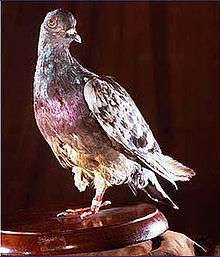Cher Ami
| Cher Ami | |
|---|---|
 The stuffed body of Cher Ami on display at the Smithsonian Institution | |
| Died |
June 13, 1919 Fort Monmouth, New Jersey |
| Place of display | Smithsonian Institution |
| Allegiance | United States of America |
| Service/branch | United States Army |
| Years of service | 1918 |
| Unit | 77th Division |
| Battles/wars | World War I |
| Awards | Croix de Guerre |
| Other work | Department of Service mascot |
Cher Ami (French for "dear friend", in the masculine) was a homing pigeon who had been donated by the pigeon fanciers of Britain for use by the U.S. Army Signal Corps in France during World War I and had been trained by American pigeoneers. She helped save the Lost Battalion of the 77th Division in the Battle of the Argonne, October 1918.[1]
World War 1 service
On October 3, 1918, Major Charles White Whittlesey and more than 500 men were trapped in a small depression on the side of the hill behind enemy lines without food or ammunition. They were also beginning to receive friendly fire from allied troops who did not know their location. Surrounded by the Germans, many were killed and wounded in the first day and by the second day, just over 190 men were still alive. Whittlesey dispatched messages by pigeon.[2] The pigeon carrying the first message, "Many wounded. We cannot evacuate." was shot down. A second bird was sent with the message, "Men are suffering. Can support be sent?" That pigeon also was shot down. Only one homing pigeon was left: "Cher Ami". She was dispatched with a note in a canister on her left leg,
We are along the road paralell (sic) to 276.4. Our own artillery is dropping a barrage directly on us. For heavens sake stop it.
As Cher Ami tried to fly back home, the Germans saw her rising out of the brush and opened fire. For several moments, Cher Ami flew with bullets zipping through the air all around her.[3] Cher Ami was eventually shot down but managed to take flight again. She arrived back at her loft at division headquarters 25 miles (40 km) to the rear in just 25 minutes, helping to save the lives of the 194 survivors. In this last mission, Cher Ami delivered the message despite having been shot through the breast, blinded in one eye, covered in blood and with a leg hanging only by a tendon.
Cher Ami became the hero of the 77th Infantry Division. Army medics worked long and hard to save her life. They were unable to save her leg, so they carved a small wooden one for her. When she recovered enough to travel, the now one-legged bird was put on a boat to the United States, with General John J. Pershing personally seeing Cher Ami off as she departed France.
Awards
Upon return to the United States, Cher Ami became the mascot of the Department of Service . The pigeon was awarded the Croix de Guerre Medal with a palm Oak Leaf Cluster for her heroic service in delivering 12 important messages in Verdun. She died at Fort Monmouth, New Jersey, on June 13, 1919 from the wounds she received in battle and was later inducted into the Racing Pigeon Hall of Fame in 1931. She also received a gold medal from the Organized Bodies of American Racing Pigeon Fanciers in recognition of her extraordinary service during World War I.[4]
Remembered
To American school children of the 1920s and 1930s, Cher Ami was as well known as any human World War I heroes. Cher Ami's body was later mounted by a taxidermist and enshrined in the Smithsonian Institution. It is currently on display with that of Sergeant Stubby in the National Museum of American History's "Price of Freedom" exhibit.[5]
Sex and color
Originally registered as a Black Check cock, Cher Ami was a Blue check, and she was discovered after death upon taxidermy procedure to be a hen. She is still erroneously represented as a cock bird at the National Museum of American History and by many other educational and military history information sources.[6][7]
Popular culture
Books
- Cher Ami by Marion Cothren
- Cher Ami a poem by Harry Webb Farrington
- Finding the Lost Battalion - Beyond the rumors, myths and legends of America's famous WWI Epic by Robert J. Laplander
- Cher Ami a short story by Heather Rounds
Film
- The Lost Battalion, a 2001 film featuring the story of Charles White Whittlesey's unit during the Meuse-Argonne Offensive.
- Cher Ami... ¡y yo!, a 2008 film directed by Miquel Pujol and produced by Accio Studios. Also known as Flying Heroes or The Aviators[8]
- Flying Home, 2015 a romantic drama, starring Jamie Dornan features the story of Cher Ami's heroic feat.
Television
- "White Collar" in Season 3 Episode 11, Cher Ami is mentioned by Caffrey while sending a message by carrier pigeon, referencing the saving of over 200 lives.
Games
- The boardgame Rivet Wars in his Second Wave expansion features a hero by the name of Cher Ami who is renowned for his use of homing pigeons.
References
- ↑ "Cher Ami "Dear Friend" WWI". Flickr. Retrieved 2008-04-26.
- ↑ "The 'Stop It' Telegram". www.lettersofnote.com. Retrieved 2010-05-26.
- ↑ Jim Greelis. "Pigeons in Military History". World of Wings. Retrieved 2007-09-13.
- ↑ National Pigeon Day. "History of Cher Ami". Retrieved 2011-03-31.
- ↑ "Cher Ami - World War I Carrier Pigeon". Smithsonian Institution. Retrieved 2008-11-26.
- ↑ "A History of Army Communications and Electronics at Fort Monmouth, New Jersey 1917 - 2007". Defense Dept., Army, Fort Monmouth Historical Office. Retrieved 2012-11-05.
- ↑ cecom.army.mil. "Cher Ami". Retrieved 2012-11-05.
- ↑ "Cher ami: The Movie". Retrieved 5 July 2013.
External links
| Wikimedia Commons has media related to Cher Ami. |
- Cher Ami at the Internet Movie Database